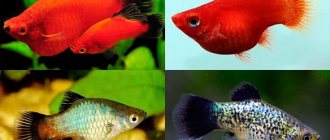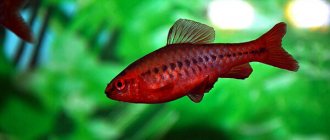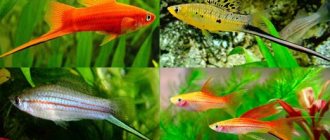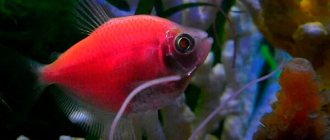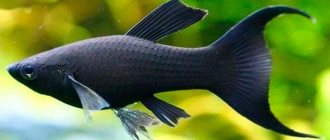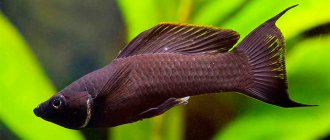Ternetia caramel fish. Description, features, types and care of thorns
Beginner aquarists love to breed small thorns from the characin family for their unpretentiousness and touching appearance. Caramels - artificially colored specimens - have become a fashionable variety of popular fish.
Artificially colored caramel thorns
Instead of the natural gray color, the fish bodies received green, yellow, pink, and blue shades due to special injections with a coloring composition. The aquarium with thorns has turned into a kaleidoscope - flocks of caramels shimmer with all the colors of the rainbow.
Description and features of caramel thorn
Wonderful fish originally from Brazilian reservoirs first appeared in Europe in the 30s of the last century, and were brought to Russia in 1946. Now thorns are so common that they can be found in every pet store.
Caramels are the undisputed favorites for attracting the attention of buyers, although new technologies for coloring fish are not welcomed by everyone. In Europe, due to protest sentiments, they do not buy such inhabitants for their aquariums.
Ternetia albino
Multicolor ternetias, as they are also called, pay for their striking appearance with compromised health. They really require more attention than their naturally colored counterparts. Owners need to remember that the pigment of bright individuals is not passed on to their heirs.
The chemical effect of the dye may weaken over time, then the outfit becomes dull and loses its expressiveness. The color fades not only in painted individuals, but also in ordinary representatives of thorns. Among the reasons are various fish diseases and stressful situations.
In nature, the thorn fish lives in local rivers of South America, but colored specimens are supplied mainly from special breeding farms in Vietnam. A long journey often affects the condition of fish susceptible to disease.
Artificially colored common thorns
After purchasing, a flock of beauties should be kept in quarantine in a separate container, only then moved to a common aquarium. If no signs of illness appear in two weeks, then the fish will delight their owners for a long time.
Ternetia is distinguished by a tall and flat diamond-shaped body. The length of the fish reaches 5.5-6 cm. An individual is ready for spawning when its size is at least 3 cm. The characteristic external features of the ternation are a pair of vertical dark stripes along the body and large fins.
Anal looks like an elegant skirt. Thanks to this remarkable part of the body, from the abdomen to the tail, the thorn cannot be confused with other inhabitants of the aquarium. The dorsal fin, narrow and high, proudly points upward. A small adipose fin is located at the tail.
Ternetia Glofish pink
Large eyes are set on the sides, the lower jaw is slightly pushed forward. The popularity of caramel fish is associated not only with its elegant color, but also with other advantages of keeping it:
- peaceful nature of the inhabitants;
- ease of reproduction;
- activity and mobility;
- accessibility of maintenance for beginner aquarists.
Small schools of fish look very impressive, evoke positive emotions, the bright outfit of the inhabitants lifts the mood, especially delights children.
Diseases
Characins have good health. If maintained incorrectly, they encounter standard diseases:
- Neon disease. Accompanied by white areas under the skin that restrict movement. In the advanced stage, the spine becomes bent. Replace the sick individual, provide it with good care, then there is a high probability that the fish will recover.
- Oodiniumosis. Introduced with new fish and plants. A golden coating appears on the body, coordination of movements is impaired, and the fish itch against the decorations and stones. The disease can be prevented by creating a quarantine for new individuals. Keep the fish in a separate aquarium for a month and monitor its condition. Treat plants in a slightly pink solution of potassium permanganate or water conditioners. Oodiniumosis is treated with copper sulfate with an increase in temperature.
- Poisoning. In unsettled tap water, thorns can be poisoned by chlorine. Ammonia poisoning occurs when the aquarium is not cleaned frequently.
- Tuberculosis. It is brought into an aquarium with a sick fish. A sick individual hides, does not eat, and the body becomes deformed. Keep the aquarium clean and inspect the fish periodically.
Types of thorns
Caramels of various colors are obtained by injection with a coloring solution. External intervention allows you to achieve bizarre results, which are of interest not only to amateurs, but also to professionals.
Ternetia veil
Chemical exposure weakens the thornets' body, but does not change their biological characteristics, behavioral characteristics, or care for them. The main popular colors of fish:
- pink;
- blue;
- yellow;
- violet;
- green.
Fashion trends in the aquarium hobby are leading to the widespread proliferation of exotic caramels. Schooling fish are bought by at least 7-9 individuals, but the more there are in the group, the better. They occupy a worthy place among other types of thorns:
- classical;
- veil;
- gold;
- albinos.
Ternetia Glofish (GloFish) are modified fish with a fluorescent glow. Ultraviolet lighting makes them even brighter. Unlike caramels, color is inherited.
Ternetia multicolor
Thorn species are created by transgenic technologies using DNA from jellyfish, red corals, and various combinations. The result is forms of green, red, orange, blue, yellow flowers.
Interestingly, the dyeing does not extend the results to the tail or fins. They still remain black or dark green. This feature influenced the second name of the ternation - mourning tetra, since the long fin frames the bottom line of the body, creating a dark outline.
Diet
Our charges are not too capricious in everything, including the menu. They welcome not only live and dry food, but also their analogues. Freshly frozen food in the form of bloodworms, brine shrimp, and daphnia is a good option for replacing classic, dry food. Rest assured: any particle of food that falls to the bottom will be eaten very quickly. But first of all, thorns eat up everything that floats in the middle layers of water.
Finely chopped spinach stems or zucchini fruits are an excellent treat for fish that will help strengthen their immunity.
Care and maintenance
The choice of aquarium is determined by plans for stocking schooling fish. An adult caramel thorn requires a volume of water of at least 10 liters. Therefore, to establish a small flock of 6-7 individuals, you need an aquarium that can hold at least 60 liters.
In practice, in addition to caramel fish, there are other inhabitants in the aquarium, so the volume of the artificial reservoir becomes optimal at 100 liters. The content of the ternation is not considered difficult. Even an inexperienced aquarist can provide comfortable living conditions for caramels. Water characteristics are allowed in the following indicators:
- temperature - 23-26°C;
- rigidity - 16°;
- acidity 6.0-7.5
Caramel thorns require mainly soft acidic water, but it has been noted that they adapt well to different conditions. The vital needs of other inhabitants of an artificial reservoir should be taken into account in creating an acceptable environment for everyone. It is recommended to change the water by about a quarter of the total volume of the aquarium once a week.
The selection of soil and vegetation creates an atmosphere of the underwater world. Harmonious use of natural biotope. Ternetia is a colored fish, so it does not need any special decoration. To suit the taste of the aquarium owner, improvised driftwood, grottoes, terraces are installed, scattered stones are placed on the river sand, and fallen leaves are placed.
Caramels can do without special shelters; they still prefer the presence of planted algae. The ideal picture for them is when plants float on the surface and do not interfere with their maneuvers in brisk movement.
All plantings can be done around the perimeter of the container so that the center remains free for the active life of the inhabitants. Small-leaved algae are preferred: Echinodorus, Cryptocoryne species, etc.
Equipment for water filtration and aeration is required as standard, as for other aquarium inhabitants. The creation of an air current of water allows the caramels to float with the flow, against it. It is optimal to direct the stream along the walls of the aquarium.
The use of fluorescent lamps maintains daylight hours up to 10 hours or more. Their power should not be high so that the caramel thorn does not receive a thermal burn if it rises to the surface. The aquarium should also be protected from direct sunlight for the same reason. Fish need soft and diffused light.
Ternetia Glofish green
Ternetia is an aquarium fish with a character, so the artificial container should be kept closed with little access to fresh air. They are usually covered with glass or some transparent material. Otherwise, the playing caramel fish jump out of the water and die.
In nutrition, the cauliflower is omnivorous, undemanding to the diet. Feeding occurs at the surface of the water. At the bottom, leftover food is picked up by other inhabitants of the aquarium. Although caramels always have an excellent appetite, they do not have a tendency to overeat. Owners should not offer excess food to aquatic inhabitants. The diet can be based on high-quality cereals.
Almost all traditional foods are suitable for feeding. Despite the cutest appearance of caramels, their origin is predatory, so preference should be given to live food: bloodworms, brine shrimp, daphnia, cyclops. Small crustaceans contain vitamins A and D, chitin, which is necessary for the digestion of fish.
Sometimes flock inhabitants can be offered frozen scraped meat. In order to prevent premature fading of color, the diet of caramel thorns needs to be diversified with mineral supplements. It is important to remember that the life expectancy, health and ability to reproduce of caramel thorns depend on the variety of the menu.
How to determine gender?
Despite the fact that at first glance, individuals of both sexes of this breed look almost identical, if you look closely, you can find differences that will help distinguish them.
- First, size: the female is always slightly larger than the male. If it is difficult to determine through the glass of the aquarium which of the fish is larger, then look at the back from above: the female will be wider, and the male, accordingly, more “flattened”.
- Secondly, the color scheme. The coloring of the male is much more pronounced, the stripes near the head are clearer, and black predominates on the body. This is especially true for the tail part of adult fish: it retains the rich black tint characteristic of young fish. The tail fin is transparent, but males have a white edge, which females do not have. If we talk about the stripes on the female’s body, then their boundaries seem a little blurred.
Difficulties in determining gender by color may arise if you purchased any of the colored varieties - the so-called caramels.
They have a very bright unnatural color, which makes it difficult to determine the outline of the pattern and the sex of the fish.
In this case, knowledge about the differences between the fins of male and female individuals will help. The dorsal fin of the male is sharper and longer; in the female it can be wider and much smoother in shape. The anal fin of the “boy” is larger, tapering closer to the tail. In a “girl,” it is wider and resembles a kind of skirt, which remains the same width from the beginning of the fin to the base of the tail.
Compatibility with other fish
The neighbors of caramel thorns in the aquarium should be commensurate fish, 4-5 cm long with a peaceful character. Ideal cohabitants include swordtails, sacbranch catfish, and labyrinthine species such as gourami. The risk of being eaten exists in newborn fish, as well as in small species such as guppies or neons. Bright caramels will make them hunt.
Compatibility of thorns with ornamental fish species is undesirable due to the desire of nimble caramels to bite the veil fins of slow neighbors. Even in their own flocks, biting attacks from relatives sometimes occur. It is not recommended to combine ternation with large predators that pretend to seize territories. Cichlazomas and astronotuses can injure caramels.
Caramel fish are quite suitable for keeping in a community aquarium with many types of fish. If the thorns have a large flock, they are more focused on internal communication. They cannot be left alone - the fish become aggressive.
Reproduction and lifespan
Grown-up fish are ready for spawning at the age of one year with a body length of 3-4 cm. Reproduction efficiency is higher in mature thornets, but you can also choose young, sexually mature caramels. Preparation begins with the placement of the selected pair and abundant feeding of the fish with live food.
A special container of 30 liters or more is prepared for spawning. The place for the aquarium should be with diffused, dim, soft light. Twilight is suitable, which can be created with sheets of paper covering the illuminated glass of an artificial pond.
For the spawning ground, dark soil, small-leaved plants, and soft acidic water are selected. For arrangement, it is good to place water moss on the bottom of the aquarium. It is recommended to maintain the water level at 7-8 cm, with a temperature of 24-25°C.
A filter is required in the container, and a thermostat is required to maintain the desired temperature. The water is left to settle for several days before filling the spawning area. It must be saturated with oxygen and contain tannins.
To do this, you can add a little boiled water to distilled water after settling, add peat extract with an acidic reaction, add willow roots and alder cones. An extract option is oak bark or weak tea.
After the fish settle in, 3-6 days later the active movement of the pair begins. The reproduction of thorns can be observed in the early morning. The male chases the female around the pond with short breaks.
The female lays hundreds of sticky eggs in small portions of up to 30 pieces. They settle on algae leaves and decorative parts of the aquarium. The male fertilizes the eggs with milt.
Spawning time lasts up to 3 hours. The total number of eggs spawned and fertilized reaches a thousand or more. Experienced aquarists note this high figure in comparison with other types of fish.
After completing the process, it is necessary to transfer the parent pair to another container so that the eggs and future fry do not end up being eaten. The mesh located at the bottom of the aquarium additionally protects the offspring from destruction.
An aquarium with thorns looks very bright and colorful
It takes about 2 days for the larvae to hatch. The water in the container should be heated to 27-28°C. Barely noticeable living crumbs stick to plants and the walls of the reservoir, and only on the third day do they begin to swim independently.
It is noteworthy that the spawning of thornets is active and does not cause problems, but the fry appear quite weak and very small in size. Initial feeding of baby ternets is carried out only with the smallest feeds. They include ground living dust, consisting, for example, of rotifers. Swimming fry can be fed with boiled yolk.
Not all fry survive; mass deaths occur. Growing individuals need to be gradually transferred to daphnia moina, small bloodworms, chopped coretra - larger foods. Hungry juveniles are first fed dry and artificial additives, and then given their usual food.
It is important for owners to monitor the condition of dry food: check the date of manufacture, shelf life, and do not store it open to prevent the development of pathogenic flora. During the period of growth, fry need to be sorted by size: large and active ones must be eliminated, giving small individuals a chance to survive.
Ternetia fish
In general, the health of thornets is good. The fish adapt well to various environments with fluctuations in acidity, hardness, and water temperature. Colored caramels are somewhat weaker than their relatives, but there are no particularities in the maintenance and treatment of these beauties. The advice of experienced aquarists applies to thornets of all types.
Disease prevention is as follows:
- increase in reservoir temperature to 30°C;
- salt baths;
- the use of antiseptics - trypaflavin or others.
A caring attitude towards aquatic inhabitants will preserve their lifespan up to 4-5 years; especially strong ones can live up to 6 years.
Breeding rules
In an aquarium, even a novice hobbyist can get numerous offspring if he follows simple rules. Prepared breeders are selected from the school - apparently healthy, active and brightly colored fish. It is better to plant them in a spawning tank - a 10-15 liter jar filled with 15-20 cm of water. For breeding, water with the following parameters is suitable:
- hardness 5-10GH;
- pH 6.4-6.7;
- temperature 27-28°C.
Tap water can be softened by boiling and acidified with peat extract. For fertilization, both a couple of thorns and a group with a predominance of males are used. A base for placing eggs is placed in the spawning tank - bunches of small-leaved plants or black synthetic threads. If spawning does not occur immediately, then you need to stimulate the process by feeding the fish high-protein live food.
The male begins to court the female, swimming around her and forcing her to rise to the upper layers of the water. He begins to press the female’s abdomen with his fins, stimulating the appearance of a portion of 20-30 eggs, which the male fertilizes. This process occurs several times until the female’s abdomen is completely empty. The total number of eggs can vary from 500 to 1.5-2 thousand.
The eggs slowly sink to the bottom and settle on plant leaves or balls of thread. After spawning is completed, it is recommended to replace part of the water with fresh water with the same parameters. Producers are removed because they do not hesitate to feast on future offspring.
If the water temperature is 28°C, then hatching accelerates and occurs after 35-40 hours. The larvae do not need to feed while they still have a yolk sac. They hang vertically for some time at the places where the eggs are attached. Having reached a size of 6-7 mm, they spread throughout the entire volume of the spawning tank.
To speed up the growth of fry, they are given zooplankton or ciliates 3-4 times a day. After a month, the body size of the fry doubles. The fish reach sexual maturity at 8 months. Individuals that have reached maximum development by this age can produce offspring. A fully formed pair of thorns is capable of producing offspring 3 to 5 times with an interval of 1.5-2 weeks.
With proper maintenance, safety and sterility of live food, these beautiful fish will delight their owner for 4-6 years.
Sexual characteristics
Caramel thorns spawn in pairs. You can choose a female and a male in a school of fish based on characteristics that are clearly visible in a comparison of body structure. Females are larger and wider. Their abdomen is more rounded. The fins are also different: the anal fin has the shape of a wide skirt, the dorsal fin is higher and sharper than the fin of the male individual.
Female and male Ternetia vulgare
The male is smaller in size, has a more flattened body shape, the dorsal fin is not so high and has a rounded shape, the anal fin has a rounded shape and looks more neat than that of the female.
Why is it so important to be able to differentiate?
Determining the sex of Ternetius is quite difficult, since the differences between females and males are not clearly expressed. However, this still needs to be done, since knowledge about the sexual composition of the school is necessary for further breeding of fish. Even if you don't intend to breed Ternetius, it's still worth knowing how to determine their sex.
The fact is that this species always lives in flocks - a lonely Ternetia will not live long. In a flock, complex relationships develop, which are based on the ratio of “girls” and “boys”. If the hierarchy is violated, then some individuals will chase and terrorize others, which is undesirable. To create a calm and harmonious environment in the aquarium, the owner needs to clearly understand the gender composition of swimming pets.
The price of thorns
Ternetias are widespread and can be found in any pet supply store or purchased online. Buying caramels is more expensive than buying ordinary thorns, ranging from 100-130 rubles.
The price depends on color preferences, order volume, age and condition of the fish. Pink thornia is very popular. Bright caramel delights lovers and delights children with its appearance.
No matter how much you have to pay for live fish, the real price is measured not by banknotes, but by genuine interest in the unusual world of the inhabitants of foreign rivers. It is human nature to conduct experiments and transform the world—the thorns in the photo are proof of this. The purchase of fish obliges the aquarist to treat the small and fragile life of caramels with care and attention.
